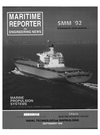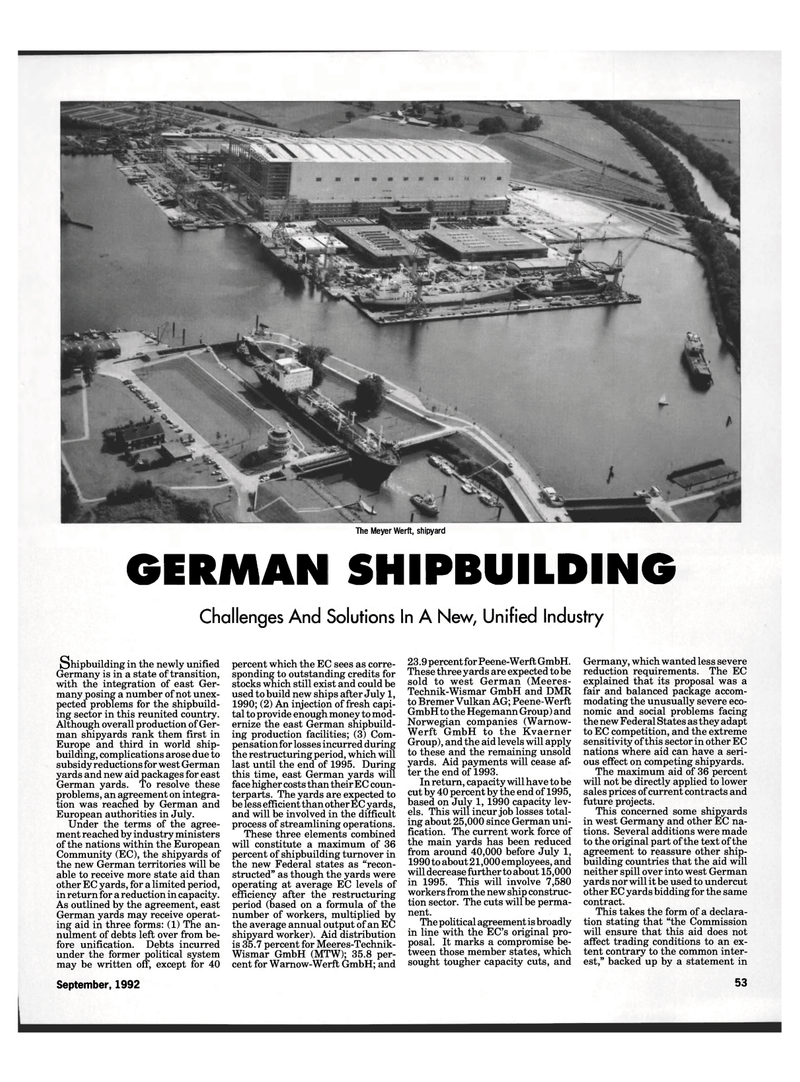
Page 55: of Maritime Reporter Magazine (September 1992)
Read this page in Pdf, Flash or Html5 edition of September 1992 Maritime Reporter Magazine
The Meyer Werft, shipyard
GERMAN SHIPBUILDING
Challenges And Solutions In A New, Unified Industry
Shipbuilding in the newly unified
Germany is in a state of transition, with the integration of east Ger- many posing a number of not unex- pected problems for the shipbuild- ing sector in this reunited country.
Although overall production of Ger- man shipyards rank them first in
Europe and third in world ship- building, complications arose due to subsidy reductions for west German yards and new aid packages for east
German yards. To resolve these problems, an agreement on integra- tion was reached by German and
European authorities in July.
Under the terms of the agree- ment reached by industry ministers of the nations within the European
Community (EC), the shipyards of the new German territories will be able to receive more state aid than other EC yards, for a limited period, in return for a reduction in capacity.
As outlined by the agreement, east
German yards may receive operat- ing aid in three forms: (1) The an- nulment of debts left over from be- fore unification. Debts incurred under the former political system may be written off, except for 40
September, 1992 percent which the EC sees as corre- sponding to outstanding credits for stocks which still exist and could be used to build new ships after July 1, 1990; (2) An injection of fresh capi- tal to provide enough money to mod- ernize the east German shipbuild- ing production facilities; (3) Com- pensation for losses incurred during the restructuring period, which will last until the end of 1995. During this time, east German yards will face higher costs than their EC coun- terparts. The yards are expected to be less efficient than other EC yards, and will be involved in the difficult process of streamlining operations.
These three elements combined will constitute a maximum of 36 percent of shipbuilding turnover in the new Federal states as "recon- structed" as though the yards were operating at average EC levels of efficiency after the restructuring period (based on a formula of the number of workers, multiplied by the average annual output of an EC shipyard worker). Aid distribution is 35.7 percent for Meeres-Technik-
Wismar GmbH (MTW); 35.8 per- cent for Warnow-Werft GmbH; and 23.9 percent for Peene-Werft GmbH.
These three yards are expected to be sold to west German (Meeres-
Technik-Wismar GmbH and DMR to Bremer Vulkan AG; Peene-Werft
GmbH to the Hegemann Group) and
Norwegian companies (Warnow-
Werft GmbH to the Kvaerner
Group), and the aid levels will apply to these and the remaining unsold yards. Aid payments will cease af- ter the end of 1993.
In return, capacity will have to be cut by 40 percent by the end of 1995, based on July 1, 1990 capacity lev- els. This will incur job losses total- ing about 25,000 since German uni- fication. The current work force of the main yards has been reduced from around 40,000 before July 1, 1990 to about 21,000 employees, and will decrease further to about 15,000 in 1995. This will involve 7,580 workers from the new ship construc- tion sector. The cuts will be perma- nent.
The political agreement is broadly in line with the EC's original pro- posal. It marks a compromise be- tween those member states, which sought tougher capacity cuts, and
Germany, which wanted less severe reduction requirements. The EC explained that its proposal was a fair and balanced package accom- modating the unusually severe eco- nomic and social problems facing the new Federal States as they adapt to EC competition, and the extreme sensitivity of this sector in other EC nations where aid can have a seri- ous effect on competing shipyards.
The maximum aid of 36 percent will not be directly applied to lower sales prices of current contracts and future projects.
This concerned some shipyards in west Germany and other EC na- tions. Several additions were made to the original part of the text of the agreement to reassure other ship- building countries that the aid will neither spill over into west German yards nor will it be used to undercut other EC yards bidding for the same contract.
This takes the form of a declara- tion stating that "the Commission will ensure that this aid does not affect trading conditions to an ex- tent contrary to the common inter- est," backed up by a statement in 53

 54
54

 56
56
